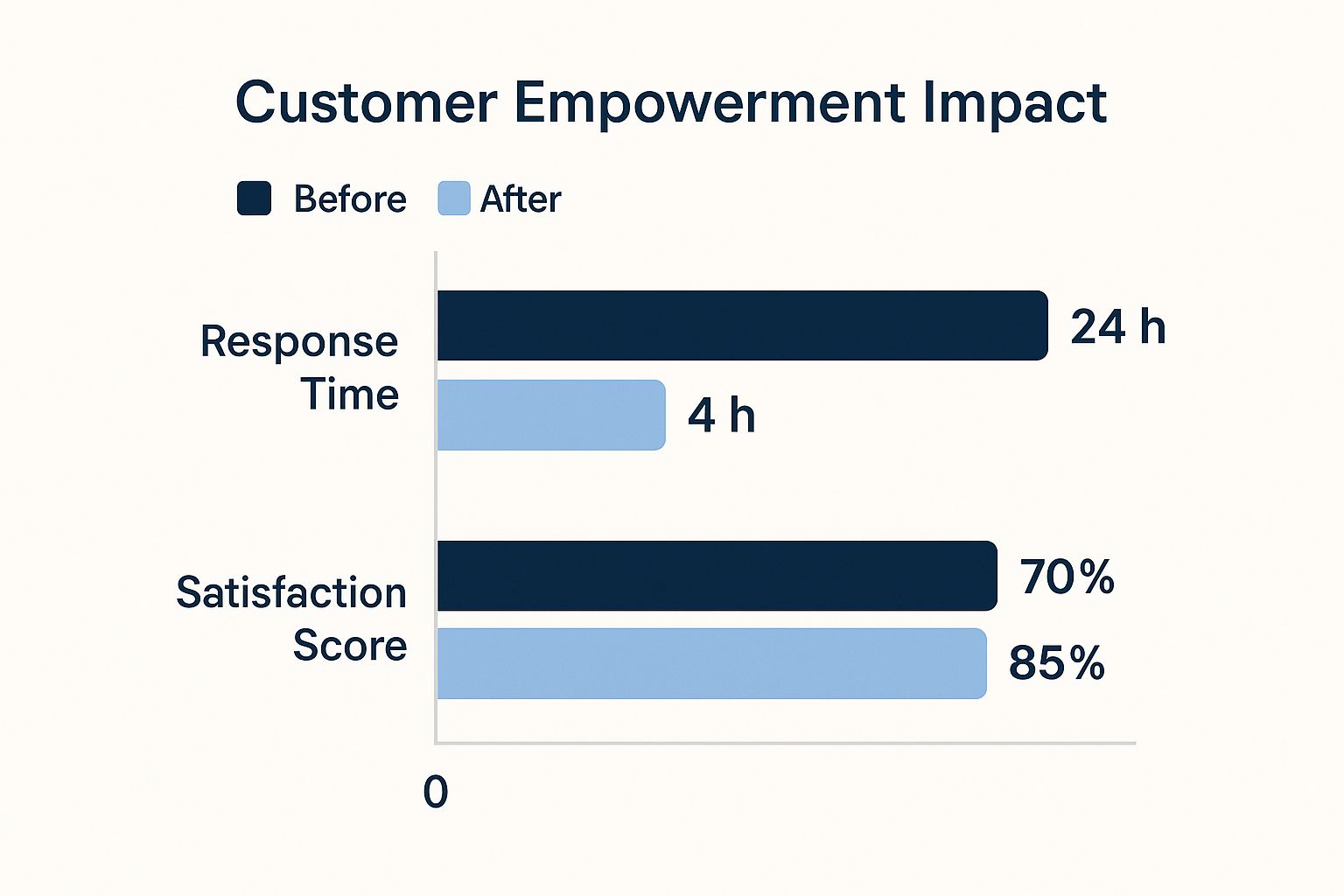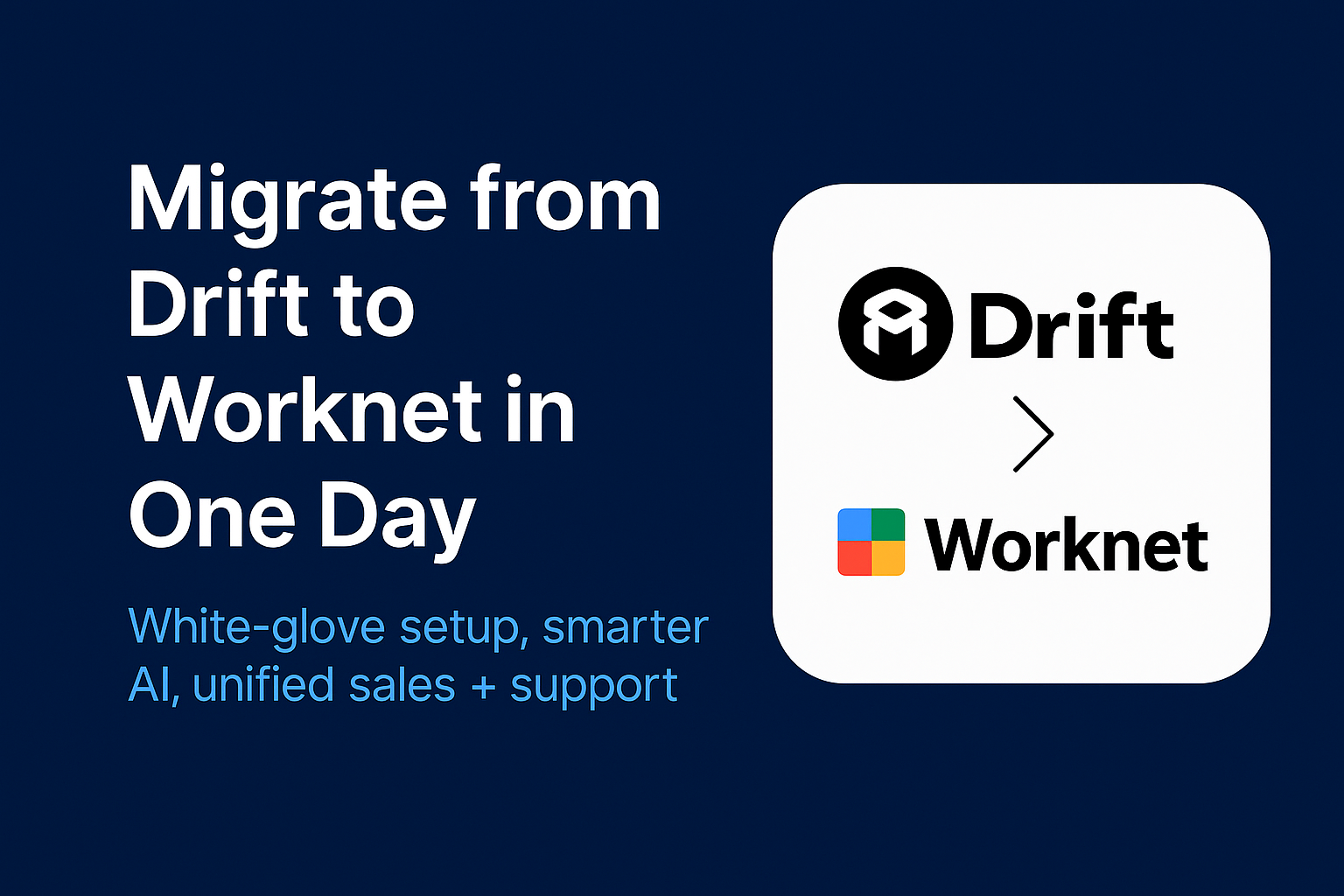How to Improve Customer Satisfaction & Drive Growth
When you boil it all down, improving customer satisfaction isn't about some grand, complicated secret. It’s about merging proactive service with real, personalized communication and, most importantly, solving problems fast. It’s a simple formula: anticipate what your customers need and handle issues so smoothly that every interaction leaves them feeling valued. That's how you build real trust and loyalty.
Why Customer Satisfaction Is Your Key Growth Metric

In a crowded market, it's tempting to see customer satisfaction as a "soft" metric—something nice to have, but not a critical driver of the business. That’s a massive oversight. Customer satisfaction isn't just about warm feelings; it's one of the most reliable predictors of your company's financial health and long-term survival. When you figure out how to improve customer satisfaction, you're actually building a more profitable and resilient business from the ground up.
Happy customers do more than just stick around. They become your most powerful marketing asset. They spend more, they’re less fussy about price, and they actively tell their friends about you. This kind of organic word-of-mouth is gold.
On the flip side, ignoring customer satisfaction is a direct financial risk. The cost of a bad experience is steep. In e-commerce, a staggering 89% of consumers have walked away from an online store for good after a single poor service interaction. Considering it costs six to seven times more to find a new customer than to keep an existing one, every person you lose is a significant hit to your bottom line. You can dig into more of the real costs of poor CX in Invesp's latest research.
From Reactive Support to Proactive Growth
Think about a typical mid-sized SaaS company. For a long time, their support was completely reactive. They only heard from customers when a support ticket landed in their inbox, which usually meant the customer was already frustrated. Unsurprisingly, their satisfaction scores were flat, and they were constantly battling churn.
Then, they decided to change their approach. Instead of just waiting for fires to start, they began proactively reaching out. They sent new users helpful onboarding tips, checked in on customers who hadn't tried a key feature, and put an AI-powered chatbot on their site to provide instant answers to common questions.
This shift wasn't minor; it was transformative. The results spoke for themselves:
- Reduced Churn: Customer churn dropped by 15% in just six months because they were solving problems before they became reasons to leave.
- Increased Lifetime Value: Engaged, supported customers were far more likely to upgrade their subscriptions, directly boosting LTV.
- Positive Brand Buzz: The company saw a wave of positive reviews and social media shout-outs, with many specifically calling out their "helpful and proactive" support team.
Key Takeaway: Moving from a reactive, break-fix model to a proactive, guidance-first mindset is the core of modern customer service. It turns a traditional cost center into a powerful engine for retention and growth. They didn't just get better at solving problems; they got great at preventing them.
To help you build out your own strategy, we've broken down the essential components into a simple framework. Think of these as the foundational pillars of any successful customer satisfaction program.
Key Pillars of Customer Satisfaction Strategy
These pillars aren't just concepts; they are actionable areas where focused effort can yield significant returns in customer loyalty and business growth. Each one reinforces the others, creating a comprehensive approach to delighting your customers at every turn.
Look Past the Numbers to Truly Understand Your Customers
If you really want to get a handle on customer satisfaction, you have to move beyond just looking at survey scores. Metrics like CSAT and Net Promoter Score (NPS) are useful, no doubt. They give you a baseline. But they only show you a tiny piece of the puzzle. They tell you what your customers are feeling, but they rarely explain why.
The real, game-changing insights are hiding in plain sight—in the unstructured, raw feedback your customers share with you every single day. Think of it this way: a survey is a multiple-choice test. Analyzing your customer conversations is like getting to read their detailed, open-ended essay answers. That's where you find the nuances, the specific frustrations, and even the brilliant ideas that will actually improve their experience.
This goldmine is sitting right there in your support tickets, live chat transcripts, social media comments, and online reviews. You just have to know how to dig for it.
Dig into Qualitative Customer Feedback
Your first move should be to start treating every support interaction as a rich source of data, not just a problem to be solved and closed. Don't just resolve a ticket and forget it. Start tagging incoming chats and emails by topic or issue.
Are you noticing a lot of people asking about the same feature? Is there a common roadblock during checkout? These patterns aren't just anecdotes; they're your roadmap for what to fix next.
For instance, I once worked with a SaaS company that noticed a pattern in their chat logs. A surprising number of trial users were asking the same basic questions about setting up a specific integration. This wasn't a major complaint that would ever torpedo a CSAT score, but it was a definite point of friction.
By creating a simple, proactive in-app tutorial that popped up for new users on that specific page, they cut the confusion before it could even turn into a support ticket. The result? A much smoother onboarding process and a clear uptick in trial-to-paid conversions.
Key Insight: Your most valuable feedback isn't the feedback you ask for; it's the feedback that's freely given. Customers are constantly revealing their pain points in everyday interactions. Your job is to build a system to listen.
Harness Sentiment Analysis
Of course, manually reading every single customer comment isn't practical as you grow. This is where technology becomes your best friend. Sentiment analysis tools can automatically scan thousands of customer conversations to get a read on the emotion behind the text. They can instantly flag interactions as positive, negative, or neutral.
This helps you spot trends you'd otherwise miss entirely. You might see that your overall CSAT score is holding steady, but sentiment related to your mobile app's performance has been slowly declining for three months. That’s a powerful early warning, giving you a chance to investigate and fix the problem before it snowballs and starts dragging down your main metrics. Learning how to boost customer satisfaction often comes down to catching these subtle shifts in emotion early on.
Connect Feedback to the Customer Journey
Gathering all this feedback is great, but the insights are only truly powerful when you connect them to specific moments in the customer's experience.
You need to map that feedback to the customer journey.
- Awareness & Purchase: What are people saying in reviews or on social media before they even become a customer? Are there common questions or misconceptions holding them back?
- Onboarding: What are the first roadblocks new users hit? Analyze their initial support tickets and chat messages to find those early friction points.
- Ongoing Use: Which features generate the most questions or complaints from your loyal, long-term customers? This can point you toward product improvements or areas where your help docs are falling short.
To build the kind of strong relationships that create real loyalty, you need to master consistent and clear communication. Adopting solid client communication best practices is a great place to start. By tying specific feedback to a journey stage, you can prioritize what to fix. Suddenly, it's clear that fixing a bug in the checkout process is far more urgent than tweaking a feature only your power users see. This targeted approach ensures you're always working on what matters most to your customers, right when it matters.
Turn Your Support Team into Customer Champions

While AI and automation are powerful allies, they can't replicate the genuine human connection that elevates a good experience to a truly memorable one. The real secret to incredible customer satisfaction lies with your people. If you're serious about creating brand evangelists, you need to build a support team that is not just technically proficient but also empathetic, proactive, and truly empowered to make a difference.
This is about shifting the goal from just closing tickets to creating positive, lasting impressions. An empowered team doesn't just read from a script; they take ownership of a customer's problem until it’s solved, turning frustration into loyalty.
Hire for Heart, Train for Skill
When you're building out your team, product knowledge and technical skills are important, but those things can be taught. What you can't easily teach is a natural service-oriented mindset. You have to look for candidates who genuinely get a kick out of helping others and who show real problem-solving grit during the interview.
Focus your hiring process on these core soft skills—they're the bedrock of exceptional service:
- Empathy: Can they truly put themselves in the customer's shoes and feel their frustration?
- Patience: Do they have the composure to stay helpful and calm, even when a customer is upset?
- Active Listening: Are they skilled at hearing what the customer really means, not just the words they're using?
I once worked with a retail brand that made a deliberate switch to prioritize empathy above all else in their hiring. Their philosophy was simple: a kind, understanding agent was far more valuable than a product whiz who couldn't connect with people. That one change completely transformed their support department.
Go Beyond the Product Manual
Once you've got the right people on board, your training needs to dig deeper than just product features and functions. A truly effective training program prepares agents for the emotional labor of customer service, which is often the toughest part of the job.
Make sure your curriculum includes dedicated time for:
- De-escalation Tactics: Teaching agents how to gracefully calm an angry customer and turn a negative interaction into a positive one.
- Positive Phrasing: Helping them learn to frame information in a good light, even when delivering bad news. For instance, instead of a blunt "That's out of stock," they learn to say, "That item has been incredibly popular! I can put you on a list to be notified the moment it's back."
- Ownership and Accountability: Instilling the principle that they own a customer's issue from the first contact to the final resolution, without passing the buck.
Expert Insight: The human element is the most critical—and frequently overlooked—part of the service puzzle. Agents who feel valued and trusted by their leaders are the ones who make customers feel truly heard and appreciated. This cultural foundation is non-negotiable for preventing burnout and keeping performance high.
The financial stakes are enormous. US companies lose a jaw-dropping $75 billion every year because of poor customer service. And despite all the automation, losing a single frontline agent can cost a business $10,000 in direct costs alone. Investing in your team isn’t just a nice-to-have; it's a financial imperative. You can find more powerful customer service statistics on this AmplifAI.com blog post.
Cultivate a Culture That Fights Burnout
A high-stress, high-pressure support environment is a recipe for burnout, which will inevitably tank your service quality. To keep your team motivated and firing on all cylinders, you have to build a supportive internal culture.
It all starts with trust. Empower your agents with the autonomy to make decisions on their own—like issuing a refund or offering a small discount—without needing a manager's sign-off for every little thing. This not only resolves issues faster but also sends a powerful message that you trust their judgment. To learn more about fostering this kind of environment, check out our guide on why customer service can be a team sport.
When you empower your people, you're not just boosting their job satisfaction. You're making a direct investment in the happiness of your customers. This creates a powerful cycle: supported agents provide superior service, which leads to happier customers and a healthier bottom line. It's a win-win.
Using AI and Tech to Elevate the Human Experience
Think of technology not as a replacement for your team, but as a powerful amplifier for their skills. When you get the strategy right, AI and modern tools can take over the repetitive, time-consuming tasks. This frees up your people to focus on what they do best: building relationships and handling the complex situations that truly define a great customer experience.
The goal isn't to phase out human agents, but to make them more effective. It's about striking the perfect balance—letting technology handle the predictable, so your team can master the unpredictable and emotional side of service. This is a fundamental concept when you're serious about figuring out how to improve customer satisfaction today.
Deploy AI for Instant, 24/7 Support
One of the quickest wins with technology is giving customers instant answers, anytime they need them. A recent Zendesk report found that a massive 81% of consumers now consider AI a normal, expected part of modern customer service. This tells us customers aren't just tolerating automation; they're actively looking for it.
AI-powered chatbots are your front line here. You can train them to provide immediate, 24/7 support for the most common questions that clog up your support queues:
- Order Status Updates: Answering "Where is my order?" without needing to escalate to a human.
- Password Resets: Handling simple account-related issues on the spot.
- Basic Product Questions: Giving quick details on features, pricing, or availability.
By automating these routine queries, you're not just giving customers the speedy, self-service options they crave. You’re also protecting your human experts' time, allowing them to apply their skills to the tougher problems that demand genuine empathy and critical thinking.
Create Deeply Personalized Interactions with a Modern CRM
Your Customer Relationship Management (CRM) system should be far more than a digital rolodex. It's the central nervous system of your customer operations, holding every interaction, purchase history, and known preference. When used correctly, a CRM unlocks a level of personalization that makes customers feel like you actually know them.
Instead of treating every interaction as a fresh start, your team gets the full context. They can see a customer's entire journey at a glance, which allows them to anticipate needs and offer proactive, relevant solutions.
Key Insight: Data-driven personalization turns one-off transactions into lasting relationships. When an agent can say, "I see you had an issue with your last order, let's make sure this one goes perfectly," it builds instant rapport and shows you truly value their business.
Spot and Save At-Risk Customers with Predictive Analytics
One of the most valuable applications of AI is its ability to see what's coming. Predictive AI analytics can sift through customer behavior data to flag individuals who are at risk of churning—often before they’ve even realized they're unhappy.
These models hunt for subtle cues, like a drop in product usage, lower engagement rates, or a series of small, unresolved support tickets. When the system flags a customer, you can trigger a proactive outreach. Maybe it’s a personalized email from a customer success manager, an offer for a one-on-one training session, or a special discount. By stepping in at just the right moment, you can turn a potential loss into a loyal fan. For a closer look at this strategy, check out our guide on creating AI-powered customer engagement.
The chart below shows just how powerful this can be, illustrating the dramatic improvements a company saw in response times and satisfaction scores after giving their team the right tech.

The numbers don't lie. Empowering your team with better tools directly translates to faster service and happier customers. It’s a clear win-win.
AI Tools for Customer Satisfaction
To make these concepts more concrete, it helps to see which tools do what. Not all AI is the same, and different platforms are designed to solve different parts of the customer satisfaction puzzle.
This table gives you a starting point for thinking about your tech stack. The key is to choose tools that address your specific pain points and integrate seamlessly into your team's existing workflow.
A Real-World Example of Proactive Tech
Imagine a major travel company that was constantly dealing with the fallout from flight delays and cancellations—a massive source of customer frustration. Instead of just waiting for the angry calls to pour in, they implemented a proactive AI system.
Now, the second a flight change occurs, the system automatically sends a notification to every affected passenger via text and email. But here’s the brilliant part: the message includes a direct link to a personalized portal. There, customers can see their alternative flight options and rebook with a single click. No waiting on hold, no talking to a stressed-out agent.
This simple, smart use of technology turned a potential disaster into a moment of empowerment. Remember that understanding what omnichannel customer service entails is key to making these different touchpoints feel connected and seamless. By using tech to get ahead of the problem, the travel company didn't just solve an issue—they proved they respected their customers' time.
How to Measure and Continuously Improve Your Strategy

Boosting customer satisfaction isn't a project you can just check off a list. It's a living, breathing part of your business—an ongoing cycle of listening, measuring, and fine-tuning your approach. To see real, lasting improvement, you need to create a feedback loop where data from every interaction informs your next move.
Think of it this way: your high-level Customer Satisfaction (CSAT) score is like a headline. It gives you a good pulse check, but the real story is in the details. The most valuable insights come from digging into the specific operational metrics that reveal why your customers feel the way they do.
Go Beyond the CSAT Score
A single number can't tell you everything. To build a complete picture of your performance, you need to track a mix of metrics that cover efficiency, customer effort, and how well you actually solve problems. These key performance indicators (KPIs) give you a much clearer view of what's happening on the ground.
Here are a few metrics I always recommend keeping a close eye on:
First Contact Resolution (FCR): This is, in my opinion, the most critical metric of all. It measures the percentage of customer issues you solve in a single interaction, with no follow-up needed. A high FCR tells you that you’re respecting your customers' time and are genuinely effective at solving their problems.
Customer Effort Score (CES): This one is beautifully simple. It just asks, "How easy was it to get your issue resolved?" A low-effort experience is a massive driver of loyalty. On the flip side, making customers jump through hoops is one of the fastest ways to frustrate them.
Average Handle Time (AHT): Speed isn't the only thing that matters, but AHT is a great health indicator for your team's efficiency. If you see it creeping up, it might signal a need for better tools, more training for your agents, or clearer internal processes.
Key Takeaway: The goal isn't just to make customers happy; it's to make their experience effortless. When getting help is easy, satisfaction naturally follows.
It also helps to see where you stand globally. A comprehensive 2025 study of over 23,000 consumers found that the global average for customer satisfaction is 76%. The report underscores that consistent, positive experiences are the universal key to high ratings. You can discover more insights about global consumer trends to benchmark your own performance.
Establish a Regular Review Cadence
Collecting all this data is useless if you don't act on it. The best teams I've seen build a disciplined routine for reviewing their metrics and turning those numbers into real-world improvements. This isn't a random, once-a-quarter meeting; it's a regular, ingrained part of how they operate.
Set up a consistent review cycle. Maybe it's a weekly tactical huddle with your team or a monthly session for more strategic planning. Whatever the frequency, make sure that during these meetings, you're not just staring at dashboards. You need to dig into the stories behind the numbers.
Real-World Example: A Continuous Improvement Loop
I once worked with an e-commerce business that was stuck with mediocre satisfaction scores. They decided to start a simple monthly metrics review, where the support manager and a few team leads would analyze their KPIs.
Here’s what their process looked like in action:
Find the Friction: In their first meeting, they saw their FCR was lagging behind their target.
Dig for the "Why": They didn't just accept the number. They dove into the actual tickets that required multiple touchpoints and found a common theme: customers were confused about their return policy.
Make a Small Tweak: They didn't launch a massive, months-long project. Instead, they made a quick, agile change. They rewrote their "Returns FAQ" page with much clearer language and added a direct link to it in their order confirmation emails.
Measure and Repeat: The very next month, they saw a 5% increase in their FCR and a noticeable bump in their overall CSAT score. They celebrated the win, then identified their next biggest friction point and did it all over again.
Over twelve months, this commitment to small, consistent, data-informed tweaks resulted in a sustained 15-point increase in their customer satisfaction. It's a perfect illustration of how to drive real improvement—it's not about grand gestures, but about the powerful, cumulative impact of many small, smart changes.
Your Top Customer Satisfaction Questions, Answered
As you start putting these ideas into practice, you’re bound to run into some specific challenges. I’ve found that most business leaders wrestle with the same handful of questions when they’re trying to figure out how to genuinely improve customer satisfaction. Let's tackle some of the most common ones I hear.
What’s the single most effective way to improve customer satisfaction quickly?
If you want the fastest, most noticeable boost in your satisfaction scores, become absolutely obsessed with First Contact Resolution (FCR). There's nothing more powerful than solving a customer's entire problem in one single interaction. It instantly builds confidence, shows you respect their time, and leaves them feeling genuinely cared for.
Getting FCR right means empowering your team. They need the right training, the right tools, and—this is crucial—the authority to make decisions without constantly escalating issues. You also need to dig into every case that isn't solved on the first try. Was it a knowledge gap? A broken internal process? A software limitation? Pinpointing and fixing those root causes is how you make real progress.
My Take: While long-term plays like personalization are vital for deep loyalty, nothing beats the immediate impact of FCR. If you can fix the problem, fix it fast, and fix it the first time, your satisfaction metrics will jump.
How can a small business with limited resources improve customer satisfaction?
Small businesses often feel outmatched by the tech budgets of larger companies, but I always tell them their size is their secret weapon. You can lean into what big corporations struggle with: authentic, human-scale service. And it doesn’t have to cost a fortune.
Focus on simple actions that have a huge impact:
- Get personal. Use your customer's name. Glance at their history so you can mention a past purchase. A simple, handwritten thank-you note tucked into an order can create a customer for life. These small touches are memorable.
- Actively seek out feedback, then shout about it. Send a personal email asking for their thoughts. When a customer gives you a brilliant idea and you implement it, thank them publicly in your next newsletter or on social media. It proves you're not just listening—you're acting on what they say.
- Make service everyone's job. On a small team, anyone can be a hero. When the founder or a key leader personally jumps in to solve a problem, it creates an unforgettable experience that no massive corporation can easily replicate.
How do I prove the ROI of investing in customer satisfaction initiatives?
This is the big one. To get buy-in and justify spending, you have to connect the dots between happy customers and a healthy bottom line. "We made people happier" isn't enough; you need to show precisely how that happiness translates into revenue.
The key is to track your satisfaction metrics (like CSAT or NPS) right alongside your core business KPIs. You're looking for clear correlations.
Here’s how you build that business case:
- Link Satisfaction to Retention: Look at your churn rate. You need to show that your most satisfied customers stick around longer. For example, you can calculate the exact revenue you saved by preventing a cohort of happy customers from leaving.
- Connect Happiness to Higher Spending: Analyze your Customer Lifetime Value (CLV). Can you demonstrate that customers with higher satisfaction scores buy more often or upgrade to premium tiers? Frame it with hard numbers: "Customers who rate us a 9/10 spend, on average, 25% more with us over their lifetime."
- Measure Referrals: Find out where your new customers are coming from. When you can prove that your happiest clients are also your best source of new, high-value leads, you've shown that great service is one of your most powerful marketing engines.
Tell a complete story: "Our initiative to improve response times boosted our CSAT by 10 points. This directly correlated with a 5% drop in churn, which saved us $50,000 in retained revenue last quarter."
Should my company focus more on AI or on human support?
This question comes up a lot, but it’s a false choice. The most effective strategy isn't "AI versus human"—it's a smart partnership between them. The goal is to use each for what they do best to create one seamless experience.
Let AI handle the high-volume, repetitive tasks. Think 24/7 answers to simple questions, order status lookups, or password resets. This gives customers the instant gratification they crave and frees up your valuable human agents from getting bogged down in routine work.
This then allows you to deploy your human experts for the moments that truly matter—the complex, emotional, or high-stakes issues that demand empathy, creative problem-solving, and nuanced judgment. Let AI handle, "What's your return policy?" so a person can expertly manage, "My order arrived damaged, and it was a very important anniversary gift." This way, you're using AI for efficiency and your people for building relationships.
Ready to see how a unified AI chat experience can transform your customer journey? Worknet.ai Inc combines intelligent, proactive chat with seamless handoffs to your expert team. We help you convert more visitors, turn trials into loyal customers, and grow lifetime value—all through a single, powerful platform. Learn how Worknet.ai can elevate your customer satisfaction.
FAQs
.png)
Lorem ipsum dolor sit amet, consectetur adipiscing elit. Suspendisse varius enim in eros elementum tristique. Duis cursus, mi quis viverra ornare, eros dolor interdum nulla, ut commodo diam libero vitae erat. Aenean faucibus nibh et justo cursus id rutrum lorem imperdiet. Nunc ut sem vitae risus tristique posuere.
Lorem ipsum dolor sit amet, consectetur adipiscing elit. Suspendisse varius enim in eros elementum tristique. Duis cursus, mi quis viverra ornare, eros dolor interdum nulla, ut commodo diam libero vitae erat. Aenean faucibus nibh et justo cursus id rutrum lorem imperdiet. Nunc ut sem vitae risus tristique posuere.
Lorem ipsum dolor sit amet, consectetur adipiscing elit. Suspendisse varius enim in eros elementum tristique. Duis cursus, mi quis viverra ornare, eros dolor interdum nulla, ut commodo diam libero vitae erat. Aenean faucibus nibh et justo cursus id rutrum lorem imperdiet. Nunc ut sem vitae risus tristique posuere.
Lorem ipsum dolor sit amet, consectetur adipiscing elit. Suspendisse varius enim in eros elementum tristique. Duis cursus, mi quis viverra ornare, eros dolor interdum nulla, ut commodo diam libero vitae erat. Aenean faucibus nibh et justo cursus id rutrum lorem imperdiet. Nunc ut sem vitae risus tristique posuere.
Lorem ipsum dolor sit amet, consectetur adipiscing elit. Suspendisse varius enim in eros elementum tristique. Duis cursus, mi quis viverra ornare, eros dolor interdum nulla, ut commodo diam libero vitae erat. Aenean faucibus nibh et justo cursus id rutrum lorem imperdiet. Nunc ut sem vitae risus tristique posuere.
Lorem ipsum dolor sit amet, consectetur adipiscing elit. Suspendisse varius enim in eros elementum tristique. Duis cursus, mi quis viverra ornare, eros dolor interdum nulla, ut commodo diam libero vitae erat. Aenean faucibus nibh et justo cursus id rutrum lorem imperdiet. Nunc ut sem vitae risus tristique posuere.
Lorem ipsum dolor sit amet, consectetur adipiscing elit. Suspendisse varius enim in eros elementum tristique. Duis cursus, mi quis viverra ornare, eros dolor interdum nulla, ut commodo diam libero vitae erat. Aenean faucibus nibh et justo cursus id rutrum lorem imperdiet. Nunc ut sem vitae risus tristique posuere.
Lorem ipsum dolor sit amet, consectetur adipiscing elit. Suspendisse varius enim in eros elementum tristique. Duis cursus, mi quis viverra ornare, eros dolor interdum nulla, ut commodo diam libero vitae erat. Aenean faucibus nibh et justo cursus id rutrum lorem imperdiet. Nunc ut sem vitae risus tristique posuere.
Lorem ipsum dolor sit amet, consectetur adipiscing elit. Suspendisse varius enim in eros elementum tristique. Duis cursus, mi quis viverra ornare, eros dolor interdum nulla, ut commodo diam libero vitae erat. Aenean faucibus nibh et justo cursus id rutrum lorem imperdiet. Nunc ut sem vitae risus tristique posuere.
Lorem ipsum dolor sit amet, consectetur adipiscing elit. Suspendisse varius enim in eros elementum tristique. Duis cursus, mi quis viverra ornare, eros dolor interdum nulla, ut commodo diam libero vitae erat. Aenean faucibus nibh et justo cursus id rutrum lorem imperdiet. Nunc ut sem vitae risus tristique posuere.

.svg)


.webp)
.webp)
.webp)





